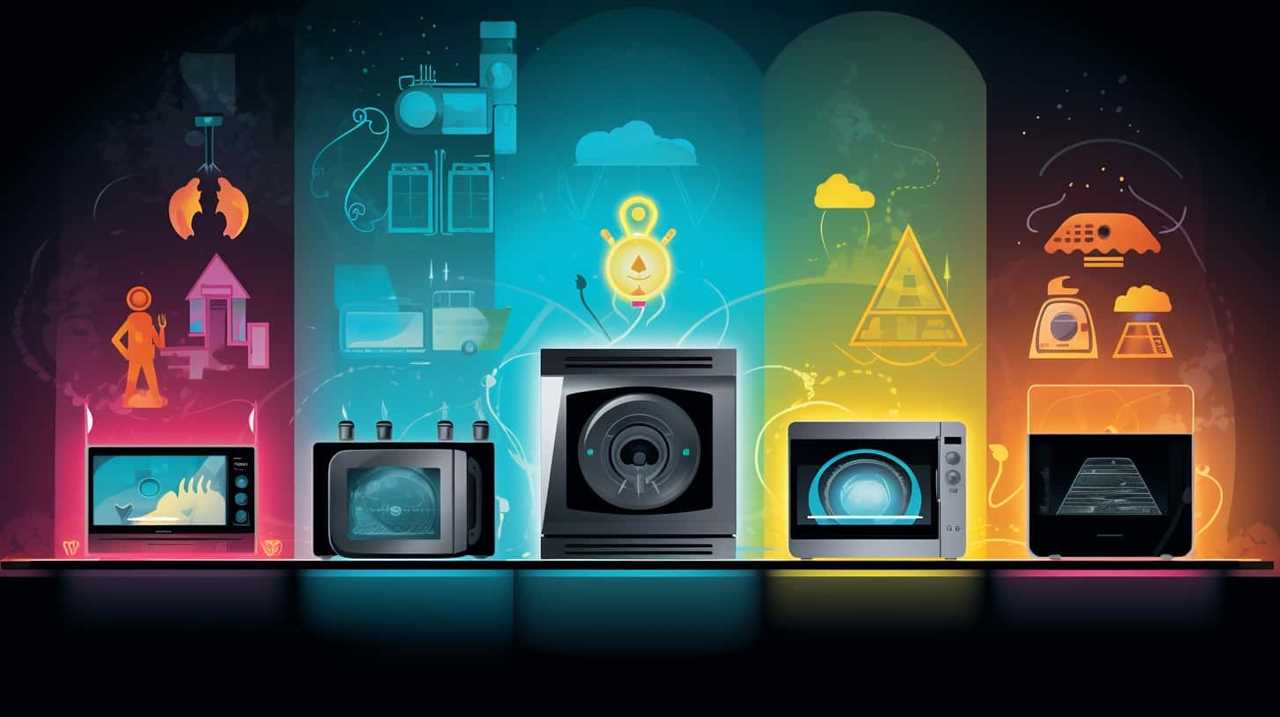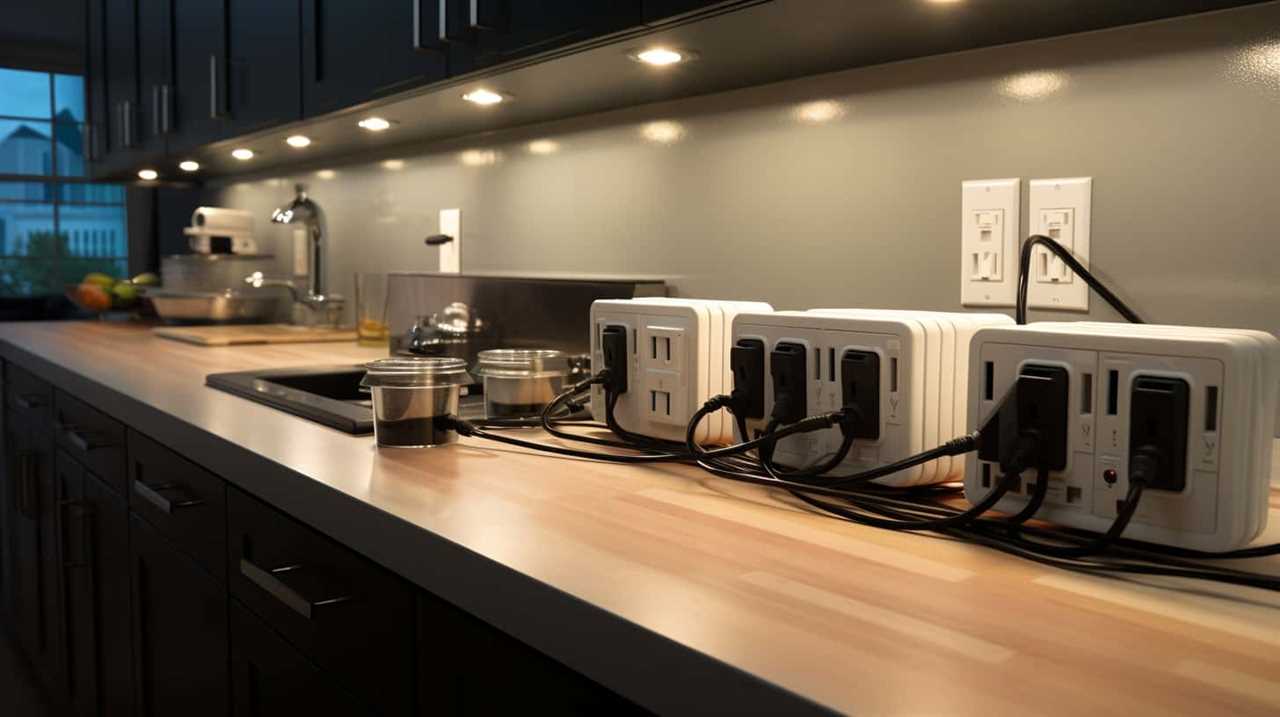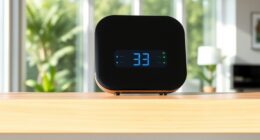We have all the information on the best energy-saving appliances you should have in your home.
From refrigerators that keep your food fresh and minimize energy consumption, to air conditioners that cool your space efficiently, and water heaters that provide hot water without wasting energy.
Don’t forget about dishwashers, washing machines, televisions, computers, ceiling fans, and heat pumps – all designed to save you money on your energy bills.
Get ready to master your home’s energy efficiency with these must-have appliances.

Key Takeaways
- Air conditioners and heat pumps are energy-efficient appliances for cooling and heating.
- Prioritize energy efficiency when choosing water heaters, such as looking for ENERGY STAR certified options.
- Look for ENERGY STAR certification and water-saving technology in dishwashers, and conserve water with energy-efficient spin cycles in washing machines.
- Choose energy-efficient cooking appliances such as convection ovens, well-insulated ovens, and microwaves with energy-efficient designs.
Refrigerators
When it comes to energy efficiency, one of the most important appliances in our home is our refrigerator. Proper refrigerator maintenance and following energy-saving tips can help reduce our energy consumption and lower utility bills. To maintain our refrigerator’s efficiency, we should regularly clean the condenser coils and ensure proper airflow around the unit. We should also keep the refrigerator temperature between 36 and 38 degrees Fahrenheit and the freezer temperature between 0 and 5 degrees Fahrenheit. Additionally, avoiding frequent door openings and ensuring a tight seal on the door gaskets can prevent cold air from escaping. By implementing these simple maintenance and energy-saving practices, we can maximize the efficiency of our refrigerator and reduce our carbon footprint.
Now, let’s move on to discussing air conditioners and how we can make them more energy efficient.
Air Conditioners
When it comes to air conditioners, there are two main points to consider: cooling cost reduction and energy-efficient AC models.
Cooling Cost Reduction
To reduce cooling costs with air conditioners, we can optimize the thermostat settings. By setting the temperature a few degrees higher during the summer months, we can significantly reduce energy consumption and save money.

Additionally, regular cooling system maintenance is important to ensure the air conditioner operates efficiently. This includes cleaning or replacing air filters, checking refrigerant levels, and inspecting the system for any leaks or damages.
Another effective way to reduce cooling costs is by upgrading insulation in the home. Proper insulation helps to keep the cool air inside, preventing it from escaping and reducing the workload on the air conditioner.
By implementing these strategies, homeowners can achieve substantial energy savings and lower their cooling costs.
Transitioning to the next section, let’s now explore energy-efficient AC models.

Energy-Efficient AC Models
We can continue to reduce cooling costs by exploring energy-efficient AC models that offer improved performance and energy savings. When it comes to cost-effective installation and energy-saving technology in air conditioners, there are several options to consider. One such option is a variable-speed air conditioner, which adjusts its cooling capacity based on the temperature demands, resulting in reduced energy consumption. Another option is a ductless mini-split system, which eliminates the need for ductwork and allows for zoned cooling, saving energy by only cooling occupied areas. Additionally, investing in a smart thermostat can optimize cooling settings and save energy by adjusting the temperature based on occupancy and time of day. By choosing energy-efficient AC models and utilizing these technologies, we can achieve both comfort and cost savings in our homes.
| AC Model | Energy Saving Technology |
|---|---|
| Variable-Speed AC | Adjusts cooling capacity |
| Ductless Mini-Split | Zoned cooling |
| Smart Thermostat | Optimize cooling settings |
Water Heaters
Let’s talk about water heaters and the key points to consider when it comes to energy efficiency.
First, cost-effective water heaters can help save money on energy bills while still providing hot water for your daily needs.
Second, tankless water heaters are a great option as they only heat water when it’s needed, reducing energy waste.

Lastly, upgrading to an energy-efficient water heater not only benefits your wallet but also the environment by reducing greenhouse gas emissions.
Cost-Effective Water Heaters
When considering cost-effective water heaters, it’s important to prioritize energy efficiency. Investing in a water heater with energy-saving technology can significantly reduce your energy consumption and lower your utility bills.
One key factor to consider is the cost-effective installation of the water heater. This means choosing a model that not only saves energy but also has a reasonable upfront cost and requires minimal installation expenses.
Look for water heaters that have high energy efficiency ratings, such as ENERGY STAR certified models. These heaters are designed to use less energy while still providing the hot water you need.

Additionally, consider the type of water heater that best suits your needs, such as tankless or heat pump water heaters, as they can further enhance energy efficiency.
Energy-Saving Tankless Options
Tankless water heaters offer an energy-saving option for homeowners seeking efficient and cost-effective water heating solutions. With their compact design and on-demand heating capabilities, they provide several benefits that make them a popular choice among energy-conscious consumers.
Here are some key advantages of energy-saving tankless water heaters:
- Energy efficiency: Tankless water heaters only heat water when it’s needed, eliminating the standby energy losses associated with traditional storage tank models.
- Cost savings: By using less energy to heat water, tankless options can help homeowners save on their energy bills.
- Space-saving: Tankless water heaters are compact and can be installed in tight spaces, freeing up valuable square footage.
- Longer lifespan: Tankless options typically have a longer lifespan compared to traditional water heaters, reducing the need for frequent replacements.
- Integration with smart home technology: Some tankless water heaters can be connected to smart thermostats, allowing for greater control and energy management.
To maximize energy savings, homeowners can also consider using energy-efficient showerheads and integrating their tankless water heater with smart thermostats for optimal energy management.

Environmental Benefits of Upgrades
Upgrading water heaters to more energy-efficient options offers significant environmental benefits. By reducing energy consumption, these upgrades help in reducing carbon emissions, a major contributor to climate change.
Traditional water heaters consume large amounts of energy to heat water, resulting in higher greenhouse gas emissions. However, with energy-efficient models, the amount of energy required to heat water is significantly reduced, leading to lower carbon emissions.
This not only helps in combatting climate change but also promotes sustainability by conserving natural resources. Additionally, energy-efficient water heaters often come with features like insulation and programmable settings, further enhancing their environmental benefits.
Dishwashers
We frequently use energy-efficient dishwashers as they help us save on electricity bills while actively cleaning our dishes. These dishwashers use less energy and water compared to older models, making them more environmentally friendly.

Here are some key features to look for when choosing an energy-efficient dishwasher:
- Energy Star certification: Look for the Energy Star label, which indicates that the dishwasher meets strict energy efficiency guidelines.
- Water-saving technology: Opt for dishwashers with features like soil sensors and water-efficient wash cycles to minimize water usage.
- Efficient drying options: Look for dishwashers with air-drying or heat-drying options, which can help save energy.
- Load sensing technology: Dishwashers with load sensing technology adjust the water and energy usage based on the size of the load, further reducing energy consumption.
- Eco-friendly detergents: Use eco-friendly detergents that are specifically designed for energy-efficient dishwashers.
Now, let’s move on to the next section about washing machines.
Washing Machines
When it comes to energy-efficient washing machines, there are a few key points to consider.
First, water-saving washing machines are designed to use less water per load, helping to conserve this valuable resource.

Second, energy-efficient spin cycles extract more water from the clothes, reducing drying time and energy consumption.
Lastly, quick wash options are available on many models, allowing for shorter wash cycles that save both time and energy.
Water-Saving Washing Machines
Water-saving washing machines are an essential addition to any energy-efficient home. These appliances not only help conserve water but also reduce energy consumption during laundry cycles. Here are some key features of water-saving washing machines:
- Energy Efficient Laundry Cycles: These machines are designed to optimize water usage by adjusting the water level based on the load size. This ensures that only the necessary amount of water is used for each cycle, reducing waste.
- Water Saving Technology: Many water-saving washing machines use advanced technologies such as sensor technology and dual spray systems. These features help to maximize cleaning efficiency while minimizing water usage.
- High Spin Speeds: Water-saving machines often have high spin speeds, which help to extract more water from the clothes. This reduces drying time and energy consumption.
- Load Sensors: These machines are equipped with load sensors that detect the amount of laundry and adjust water levels accordingly. This prevents overfilling the drum and conserves water.
- Eco-Friendly Detergent Options: Some water-saving washing machines also offer eco-friendly detergent options. These detergents are formulated to work effectively with less water, further enhancing the energy-saving benefits.
Investing in a water-saving washing machine is a smart choice for anyone looking to reduce their environmental footprint while enjoying the convenience of clean clothes.

Energy-Efficient Spin Cycles
One of the key features of energy-efficient washing machines is their ability to maximize water extraction through high spin speeds.
Energy-efficient laundry machines are designed to remove as much water as possible from clothes during the spin cycle. This not only reduces drying time but also saves energy.
By spinning at high speeds, these machines can extract more water, resulting in shorter drying cycles and lower energy consumption.
Additionally, energy-efficient washing machines often offer spin cycle alternatives, allowing users to adjust the speed and intensity of the spin cycle based on their specific needs. These alternatives provide flexibility while still maximizing water extraction and energy efficiency.

When choosing an energy-efficient washing machine, it’s important to consider its spin cycle capabilities and options to ensure optimal water extraction and energy savings.
Quick Wash Options
After researching the various options available, we found that using quick wash cycles on energy-efficient washing machines can significantly reduce both water and energy consumption. Here are some benefits of using the quick wash option:
- Time-saving: Quick wash cycles are designed to clean clothes in a shorter amount of time compared to regular cycles. This is perfect for those who are always on the go and need their laundry done quickly.
- Water-saving: Quick wash cycles use less water compared to regular cycles, making them more environmentally friendly and cost-effective.
- Energy-saving: By reducing the duration of the wash cycle, quick wash options also help save energy, resulting in lower electricity bills.
- Ideal for lightly soiled clothes: Quick wash cycles are best suited for lightly soiled clothes that don’t require intensive cleaning.
- Extended garment lifespan: Since quick wash cycles are gentler on fabrics, they help prolong the lifespan of your clothes, reducing the need for frequent replacements.
Using the quick wash option on energy-efficient washing machines can provide a convenient and eco-friendly way to get your laundry done efficiently.
Dryers
Dryers play a crucial role in our household energy consumption. When it comes to energy efficient dryers, there are a few key features to consider.

Look for models that have earned the ENERGY STAR label, as these are designed to use less energy without sacrificing performance.
Another important factor is reducing drying time. Opt for dryers that have moisture sensors, which detect when clothes are dry and automatically shut off the machine. This not only saves energy but also prevents over-drying and wear and tear on your clothes.
Additionally, choosing a dryer with a high spin speed can help extract more water from your laundry, reducing drying time and energy consumption.
Now, let’s move on to discussing energy efficient ovens.

Ovens
When it comes to energy efficient ovens, we should consider a few key factors. Here are some important points to keep in mind:
- Opt for convection ovens: These ovens use fans to circulate hot air, reducing cooking time and energy consumption.
- Look for ovens with self-cleaning features: Self-cleaning ovens use high heat to burn off food residues, eliminating the need for harsh chemicals and reducing energy waste.
- Consider smart ovens: Smart ovens can be controlled remotely through smartphone apps, allowing you to monitor and adjust cooking settings, saving energy by avoiding overcooking.
- Choose ovens with good insulation: Well-insulated ovens retain heat more effectively, reducing energy loss and improving cooking efficiency.
- Utilize energy efficient cooking methods: Use smaller pans, preheat the oven only when necessary, and avoid opening the oven door frequently to maintain temperature.
Stoves
Moving on to the topic of stoves, let’s explore their energy efficiency and how they can contribute to a more environmentally friendly kitchen. Stoves are an essential appliance in any kitchen, and proper stove maintenance and safety practices are crucial for optimal performance and longevity. Regular cleaning and inspection of burners, oven components, and ventilation systems can improve energy efficiency and prevent potential hazards. Additionally, using the right size cookware, keeping burner flames steady, and matching the pot size to the burner can help conserve energy. Stove safety is also important to avoid accidents and reduce energy waste. Always ensure proper ventilation, keep flammable materials away, and never leave a stove unattended. By following these tips, you can maximize energy efficiency and safety in your kitchen.
| Stove Maintenance | Stove Safety | Energy Efficiency |
|---|---|---|
| Regular cleaning | Proper ventilation | Right size cookware |
| Inspection of burners | Keep flammable materials | Steady burner flames |
| Cleaning oven components | away from the stove | Match pot size to burner |
Microwaves
Now let’s shift our focus to microwaves and explore their energy efficiency and how they can contribute to a more environmentally friendly kitchen.
Microwaves can be a convenient and energy-saving option for cooking. Here are some energy-saving features and cooking efficiency benefits of microwaves:

- Sensor cooking: Microwaves with sensor cooking technology can automatically adjust the cooking time and power level based on the food’s moisture and temperature, resulting in more efficient cooking.
- Power-saving mode: Some microwaves have a power-saving mode that reduces energy consumption when the appliance isn’t in use.
- Quick heating: Microwaves can heat food quickly, which helps to save time and energy compared to traditional ovens or stoves.
- Compact size: Microwaves are typically smaller than other cooking appliances, allowing for more efficient use of space in the kitchen.
- Energy-efficient design: Many microwaves are designed with energy-saving features such as LED displays and efficient insulation.
Light Bulbs
Continuing our exploration of energy-efficient appliances, let’s now turn our attention to light bulbs and their impact on energy consumption in the home.
Energy-efficient bulbs, such as LED lighting, offer numerous benefits for homeowners. LED stands for light-emitting diode, and these bulbs use significantly less energy than traditional incandescent bulbs. They’re highly efficient, converting most of the energy they use into light rather than heat.
LED bulbs also have a longer lifespan compared to incandescent bulbs, lasting up to 25 times longer. This not only reduces the frequency of bulb replacements but also saves money in the long run.
Additionally, LED lighting provides better quality light, with options for different color temperatures and dimming capabilities.

Televisions
As we shift our focus to televisions, it’s important to consider their impact on energy consumption in our homes. Here are some key points to keep in mind:
- Energy efficient screen technology: Look for televisions that utilize LED or OLED screens, as these technologies are more energy efficient compared to traditional LCD screens.
- Smart TV features: Smart TVs allow you to access online streaming services, browse the internet, and use various apps. However, these features can consume more energy. Opt for models with energy-saving modes or timers to reduce unnecessary power usage.
- Screen size: Larger screens generally consume more energy. Consider the appropriate screen size for your needs to avoid excessive energy consumption.
- Standby power: TVs often consume power even when not in use. Look for models with low standby power consumption or use power strips to easily turn off the TV completely when not in use.
- Energy Star certified: Choose televisions that are Energy Star certified, as they meet strict energy efficiency standards and can help reduce your energy consumption.
Computers
Discussing computers, we recommend considering their impact on energy consumption in our homes. Computers are an essential part of our daily lives, but they can consume a significant amount of energy. When choosing a computer, it is important to look for energy efficient design and consider the computing power required for our needs. To help you make an informed decision, we have created a table comparing three different computers based on their energy efficiency and computing power.
| Computer Model | Energy Efficiency | Computing Power |
|---|---|---|
| Model A | High | High |
| Model B | Medium | Medium |
| Model C | Low | Low |
Ceiling Fans
When considering energy efficiency appliances, it’s important to evaluate the impact of ceiling fans on our energy consumption. Ceiling fans aren’t only functional, but they can also help reduce energy usage and costs.
Here are some important factors to consider when choosing the right ceiling fan:

- Energy efficiency: Look for fans with the Energy Star label, as they meet strict energy efficiency guidelines and can save up to 60% more energy than conventional fans.
- Size and airflow: Consider the size of the room and choose a fan with the appropriate blade span to ensure optimal airflow and comfort.
- Installation: Hiring a professional for ceiling fan installation ensures proper wiring and mounting for safe and efficient operation.
- Controls: Opt for fans with remote controls or wall-mounted switches to easily adjust speed and lighting.
- Features: Look for fans with reversible motor direction, allowing for both cooling in the summer and distributing warm air during the winter.
Heat Pumps
Heat pumps are an efficient option for both heating and cooling our homes. By transferring heat from one place to another, they can provide warmth in the winter and coolness in the summer.
This not only ensures year-round comfort but also results in lower energy consumption, reducing our environmental impact and saving us money on utility bills.
Efficient Heating and Cooling
We’ve found that one appliance that stands out when it comes to efficient heating and cooling is a heat pump. Heat pumps are highly efficient heating systems that can also provide cooling during the summer months.
Here are some key benefits of using a heat pump:

- Energy Savings: Heat pumps can save up to 50% on heating and cooling costs compared to traditional HVAC systems.
- Versatility: Heat pumps can both heat and cool your home, eliminating the need for separate systems.
- Comfort: Heat pumps distribute air evenly throughout your home, providing consistent heating and cooling.
- Environmentally Friendly: Heat pumps use renewable energy sources, such as the air or ground, making them more eco-friendly.
- Smart Technology: Many heat pumps come with energy-saving thermostats that allow you to control and schedule temperature settings for maximum efficiency.
Investing in a heat pump can help you achieve efficient heating and cooling while reducing energy consumption and saving money.
Lower Energy Consumption
As homeowners, it’s important for us to consider the lower energy consumption of heat pumps, which can greatly contribute to reducing our overall energy usage and costs.
Heat pumps are highly efficient appliances that provide both heating and cooling functions. They work by transferring heat from one place to another, rather than generating heat themselves. This means that for every unit of electricity they consume, they can produce up to three units of heat or cool air.
By using heat pumps instead of traditional heating and cooling systems, we can save a significant amount of energy and reduce our carbon footprint.

To maximize the energy-saving benefits of heat pumps, it’s important to properly maintain them, ensure proper insulation, and adjust the thermostat settings for optimal efficiency.
Frequently Asked Questions
How Can I Determine the Energy Efficiency Rating of a Refrigerator?
To determine the energy efficiency rating of a refrigerator, we can look for the Energy Star label or check the appliance’s yellow EnergyGuide sticker. These labels provide valuable information and energy saving tips.
What Are Some Common Energy-Saving Features Available in Air Conditioners?
Some common energy-saving features available in air conditioners include smart thermostat integration and programmable temperature settings. These features help optimize energy usage and improve overall efficiency, making them great options for energy-conscious consumers.
Are There Any Energy-Efficient Options for Water Heaters That Do Not Require Significant Upfront Costs?
There are energy-efficient options for water heaters that don’t require significant upfront costs. Some examples include tankless water heaters and heat pump water heaters. These options can help save energy and reduce utility bills.

Can Using a Dishwasher Actually Save Water Compared to Hand Washing?
Using a dishwasher can actually save water compared to hand washing. It’s ironic, right? When it comes to energy consumption, electric stoves are more efficient than gas stoves. And for the environment, cloth towels beat paper towels.
Are There Any Energy-Efficient Dryers Available That Do Not Require Venting?
There are energy-efficient dryers available that do not require venting. These eco-friendly laundry solutions are designed to use less energy and can be a great addition to an energy-efficient home.
Conclusion
In conclusion, by investing in energy-efficient appliances such as refrigerators, air conditioners, water heaters, dishwashers, washing machines, televisions, computers, ceiling fans, and heat pumps, we can significantly reduce our energy consumption, lower our utility bills, and contribute to a more sustainable future.
These appliances not only provide convenience and comfort but also help protect our environment, making them a wise choice for both our wallets and the planet.










